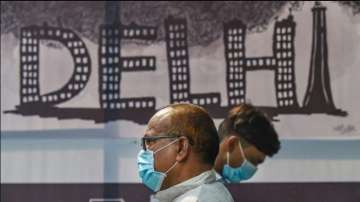Delhi-NCR shrouded by haze; air quality enters 'very poor' zone
The national capital's air quality hit an eight-month low on Thursday with stubble burning accounting for only six per cent of the city's PM2.5 concentration, according to government agencies.

The national capital's air quality hit an eight-month low on Thursday with stubble burning accounting for only six per cent of the city's PM2.5 concentration, according to government agencies. NASA's satellite imagery showed a large cluster of farm fires near Amritsar, Patiala, Tarn Taran, and Firozpur in Punjab, and Ambala and Rajpura in Haryana.
Union Environment Minister Prakash Javadekar has urged the Punjab government to curb stubble burning.
The Ministry of Earth Sciences' air quality monitor, SAFAR, said the wind direction was partly favourable for the transport of smoke from farm fires and "hence, an increase in contribution in Delhi's PM 2.5 (concentration) is expected".
Delhi recorded a 24-hour average air quality index (AQI) of 312. The last time the air quality hit such a poor level was in February with an AQI 320. The 24-hour average AQI was 276 on Wednesday, which falls in the 'poor' category. It was 300 on Tuesday, 261 on Monday, 216 on Sunday and 221 on Saturday.
An AQI between 0 and 50 is considered 'good', 51 and 100 'satisfactory', 101 and 200 'moderate', 201 and 300 'poor', 301 and 400 'very poor', and 401 and 500 'severe'.
According to SAFAR data, the contribution of farm fires to Delhi's PM2.5 concentration was around 6 per cent on Thursday. It was only around one per cent on Wednesday and around 3 per cent on Tuesday, Monday and Sunday.
A senior scientist at the India Meteorological Department said the wind direction was northwesterly and the wind speed 15 kilometres per hour, which was favourable for the transport of smoke from farm fires.
Asserting that the share of stubble burning to pollution levels changes every day, the Union Environment Ministry tweeted, "Last year, between Oct 8 and Dec 9, the share of stubble burning in air pollution in Delhi (as per SAFAR data), was greater than 15 per cent on six days, while on a single day it was greater than 40 per cent."
PM 10 levels in Delhi-NCR rose to 311 micrograms per cubic meter (µg/m3) at 5 pm on Thursday -- the highest in this season so far. PM10 levels below 100 µg/m3 are considered safe in India.
PM 10 is particulate matter with a diameter of 10 micrometres and is inhalable into the lungs. These particles include dust, pollen and mould spores. The levels of PM 2.5 – finer particles which can even enter the bloodstream – were 156 µg/m3.PM 2.5 levels up to 60 µg/m3 are considered safe.
Delhi's Environment Minister Gopal Rai on Thursday wrote to the Central Pollution Control Board (CPCB) and the Environment Pollution (Prevention and Control) Authority, asking them to shut down in a week 11 coal-fired power plants within 300 kilometres of Delhi which have missed two deadlines to meet the pollution control norms.
The CPCB said it has set up 50 teams which will keep an eye on violations leading to air pollution during winters.
The Graded Response Action Plan (GRAP) -- a set of anti-pollution measures followed in Delhi and its vicinity according to the severity of the situation -- also came into force on Thursday.
It was notified by the Ministry of Environment and Forests in 2017 for implementation through the Supreme Court-mandated Environment Pollution (Prevention and Control) Authority.
The measures under GRAP include increasing bus and metro services, hiking parking fees and stopping use of diesel generator sets when the air quality turns poor.
When the situation turns 'severe', GRAP recommends closure of brick kilns, stone crushers and hot mix plants, sprinkling of water, frequent mechanised cleaning of roads and maximising power generation from natural gas.
The measures to be followed in 'emergency' situation include stopping the entry of trucks in Delhi, ban on construction activities and introduction of the odd-even car rationing scheme.
EPCA, however, had earlier told Delhi, Haryana, Rajasthan and Uttar Pradesh that they "should try and avert the need to take other emergency measures for pollution control as the economy is already under stress post-lockdown.
Therefore, our combined effort is to ensure that there is no further disruption".
With Delhi-NCR bracing for months of poor air quality, experts have warned that high levels of air pollution can aggravate the COVID-19 pandemic.
Severe air pollution in Delhi is a year-round problem, which can be attributed to unfavourable meteorological conditions, farm fires in neighbouring regions and local sources of pollution.
According to an analysis by the Council on Energy, Environment and Water, a Delhi-based think tank, transportation contributes the most -- 18 to 39 per cent -- to the national capital's air pollution.
Road dust is the second-largest source of air pollution in the city (18 to 38 per cent), followed by industries (two to 29 per cent), thermal power plants (three to 11 per cent) and construction (eight per cent).